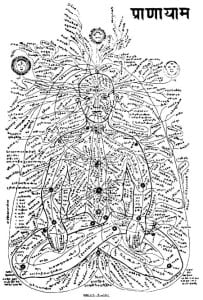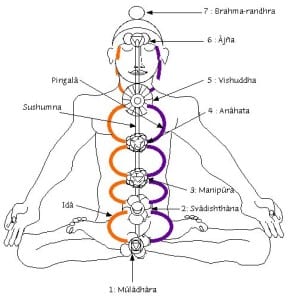If you have limited time for pranayama – yoga’s breathing techniques – nadi shodhana or alternate nostril breathing is the most important one.
The Hatha Yoga Pradipika (a medieval yoga manual if you like) lists nadi shodhana as a precursor to pranayama practice.
It’s a gem of a practice that brings glimpses of serenity to everyday life.
Apart from feeling instantly calming and centring, its benefits include:
– Reducing stress and anxiety
– Calming the nervous system (the sympathetic branch linked to our flight/fight response)
– Clearing the mind
– Facilitating emotional balance
– Assisting with good sleep
– Lowering blood pressure
– Balancing the body’s subtle energy channels (the nadis, see below) and, it is said, the two hemispheres of the brain
– Balancing and purifying body and mind so that they become ‘light and bright’ (Hatha Yoga Pradipika)
– Internalising our awareness and focusing the mind in preparation for meditation and self-realisation
The positive health effects of alternate nostril breathing continue to be investigated and evidenced in academic research.
How does it work? Prana, nadis, chakras …
This is where we step into yoga’s esoteric anatomy and an exploration of moving from the gross to the subtle, the source of yoga’s particular, profound energy and power.


The pranic body – so many nadis! Ida, pinagala, sushumna nadis, chakras
Image: original source unknown Image: V. S. Basaati
Prana, our life force (also breath and cosmic energy) runs throughout thousands of nadis in our body (all the fine black lines in the image on the left). In gross terms nadis are the channels in our body that carry our blood, water, air, nutrients etc. such as our arteries, veins and bronchioles. In our subtle body, nadis carry our vital, cosmic or spiritual energy and consciousness. Various ancient yoga texts put their number anywhere between 72,000 and over 300,000.
The three most prominent nadis – which originate at the base of the spine and meet at each of our chakras or energy centres – are ida (on the left), pingala (on the right) and sushumna (at the centre). Ida represents the nadis of the moon, pingala the sun and sushumna fire. Nadi shodhana literally means purification of the nadis.
In brief, alternate nostril breathing is said to purify and balance ida and pingala nadis so that prana can rise freely through sushumna nadi. This leads to samadhi or bliss, as kundalini Shakti (the ‘serpent power’ or divine, feminine cosmic energy) awakens and uncoils from the base of the spine and rises through sushumna nadi, some traditions say to unite with Shiva (the masculine form of the divine) at the crown centre, symbolised by the thousand-petalled lotus. At this point the practitioner no longer experiences any sense of separation, instead becoming one with the universe.
The ultimate aim of hatha yoga is to awaken kundalini. In the tradition of Tantra, when kundalini is asleep, a person is lost in a sense of individuality. When kundalini awakens, individuality is shattered into cosmic awareness.
If this seems theoretical (or far-fetched) rest assured that prana, its movement and the chakras are all palpable, even in everyday life. All is revealed through practice.
Best time to practice
Alternate nostril breathing is ideal in the evening, especially if you have had a busy day. Even 5 minutes of practice before bedtime will assist with winding down and sleeping well, as long as it is done consistently over a period of time. Try it every evening for just a week and you’ll notice some of its effects.
Practice in a quiet, well-ventilated area. Take as much support as you need in order to sit comfortably with the spine straight. You can find some tips for sitting here.
For seasoned practitioners, in the context of a longer morning pranayama practice that begins with dynamic techniques, nadi shodhana is often taken towards the end of the practice. This helps to settle our energy. Bear in mind though that a full pranayama practice is actually best taken before asana in the morning so that we return to a more external disposition (rather than remaining too ‘cosmic’) for the day to come. In the evening, it would come after asana and before meditation.
How to start
Nadi shodhana is widely accessible and often taught in yoga classes. However, one should ideally be comfortable with diaphragmatic breathing first, and be able to breathe steadily in and out for a count of at least 4, with a smooth breath that is consistent in length and quality at the beginning, middle and end of each breath. Many yoga traditions also instruct practice in breathing in through both nostrils and then alternately out through one as preparation for nadi shodhana. For preparatory tips, see here.
Take the mudra (hand gesture) that is shown here:
Throughout the practice the thumb is used to close the right nostril and the fourth finger to close the left (feel free to use the other hand if you are left-handed). The second and third fingers remain close to the palm of the hand. An alternative is to keep them at the third eye centre, the point between the eyebrows. Just see which feels most comfortable for you.
Raise the elbow and keep it lifted as much as possible:
The other hand rests on the knee, with the palm facing up or down according to what feels best for you, and with the thumb and index finger gently touching if you like.
Begin with a count of 4 for each breath. Ensure the nostrils are clear. Release an exhalation through the left nostril. To start the cycle, breathe in through the left nostril, then out through the right, in through the right then out through the left to complete the first cycle. Repeat for up to 10 cycles, as long as that is comfortable. Stop at any time if it is not. End your final cycle by breathing out through the left nostril.
How to take it further
If you wish, you can – taking your time, over several months and years – lengthen each of your breaths to a count of 10, as long as they remain steady and comfortable, for up to 15 minutes. Mula bandha, the root lock, can be used throughout, or at least on every exhalation. The mind’s focus can be held at ajna chakra, the third eye centre, or taken there on the inhalation, and then down to the annahata chakra, the heart centre, on the exhalation. The head can be lowered throughout in a half or full jalandhara bandha, throat lock. (Other approaches may use a different form of progression).
Any use of retentions would be instructed by a teacher. For alternate nostril breathing in everyday life they aren’t necessary (or recommended).
There is also a psychic version of alternate nostril breathing in which it is practised mentally rather than physically, and this extremely subtle and therefore powerful version really works.
Note that anyone with low blood pressure would need to consult with a teacher and/or their doctor about the suitability of alternate nostril breathing.
Nadi shodhana is an important and often much-loved practice among yoga practitioners. Some knowledge of its esoteric properties makes it all the more meaningful and fascinating I find.
I hope this gives you some inspiration to try or explore nadi shodhana further.
Feel free to leave a comment below, and to share this post with any friends who would be interested in knowing more about it – and tasting serenity in daily life.
Photos: author’s own

